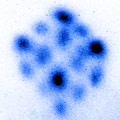Images
In the course of communicating our scientific findings, we often prepare illustrations and photographs that may be of interest to the general public and the media. A selection of these images are available for downloading here.
Images for download

- Title: Magneto-Electrostatic Trap
- Credit: Hans Green
- Reference: B. C. Sawyer, B. L. Lev, E. R. Hudson, B. K. Stuhl, M. Lara, J. L. Bohn, and J. Ye,
"Magnetoelectrostatic trapping of ground state OH molecules,"
Physical Review Letters 98, 253002 (2007).
- Caption: Drawing of the magneto-electrostatic trap used to confine neutral OH molecules at a temperature of 30 mK. The high-current coils (blue) apply a magnetic trapping field. The surrounding electrodes (red) allow for the application of either homogeneous or inhomogeneous electric fields to the trapped OH sample. This design facilitates the study of polar molecule collisions in the presence of external electric fields.
- Download: Low Medium High Resolution

- Title: Strontium Optical Atomic Clock Works
- Credit: Tetsuya Ido
- Reference: Martin M. Boyd, Tanya Zelevinsky, Andrew D. Ludlow, Seth. M. Foreman,
Sebastian Blatt, Tetsuya Ido, and Jun Ye, Optical atomic coherence at
the 1-second time scale, Science 314, 1430 (2006).
Martin M. Boyd, Andrew D. Ludlow, Sebastian Blatt, Seth M. Foreman, Tetsuya Ido, Tanya Zelevinsky, and Jun Ye, 87Sr Lattice Clock with Inaccuracy below 10-15, Physical Review Letters 98, 083002/1-4 (2007).
- Caption: A magneto-optical trap holds a cloud of cold strontium atoms inside an optical atomic clock.
- Download: Low Medium High Resolution

- Title: Atomic Air Force
- Credit: Tom Loftus
- Reference: Thomas H. Loftus, Tetsuya Ido, Andrew D. Ludlow, Martin M. Boyd, and Jun Ye.
Narrow Line Cooling: Finite Photon Recoil Dynamics.
Physical Review Letters 93 (7), 073003 (2004).
- Caption: This colorized image shows momentum packets of laser-cooled strontium atoms forming a "cube" as they fly away from the center of a cold atom cloud. The momentum packets appear at the corners, midpoints, and centers of each cube face.
- Download: Low Medium High Resolution

- Title: Molecular Fingerprinting
- Credit: Jeffrey Fal
- Reference: M. J. Thorpe, K. D. Moll, R. J. Jones, B. Safdi, and J. Ye,
Broadband cavity ringdown spectroscopy for sensitive and rapid molecular detection.
Science 311, 1595 (2006).
- Caption: Cavity ringdown spectroscopy uses many frequencies of infrared laser light to identify trace amounts of atoms and molecules. Each chemical absorbs light at characteristic frequencies, whose pattern forms a signature, or fingerprint, for identifying it.
- Download: Low Medium High Resolution

